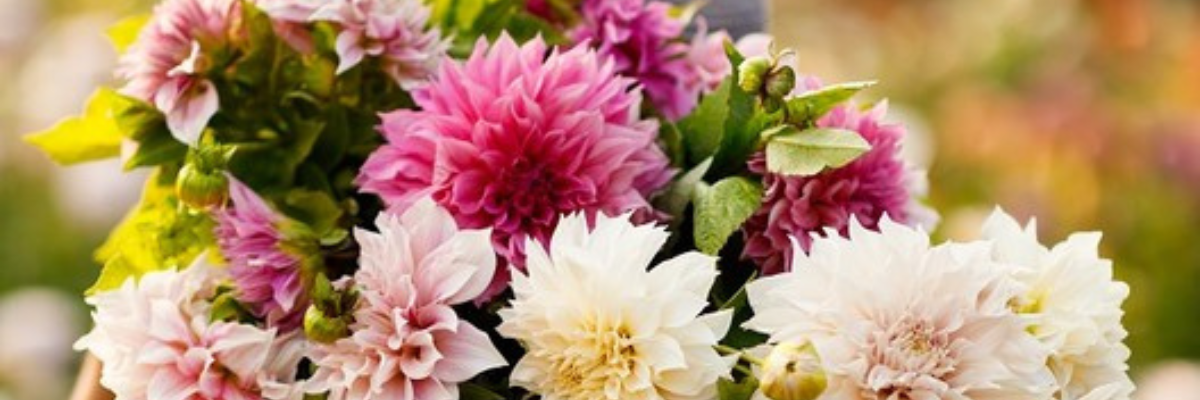Let’s talk about dahlias
Dahlias are becoming increasingly popular in landscapes and make excellent additions to border plantings, flowerpots, and cut-flower gardens. They flower continuously from summer through the first frost and will bloom prolifically if spent flowers are removed regularly. They do best in full sun and prefer well-drained sandy soils but will tolerate heavier clay soils, especially if amended with sand or peat moss.
Dahlias can grow as short as 12 inches and as tall as six feet depending on the type. Classified by their size, shape, and color, the endless varieties of dahlias available means there’s something for everyone! Colors range from yellow, pink, purple, red, scarlet, orange, to white and several varieties are multi-colored, featuring stripes and two-toned petals.
Dinnerplate dahlias
Dinnerplate dahlias are the most dramatic of dahlias with huge blooms up to 12 inches across! Dinnerplate is not actually an official classification, as these magnificent blooms are registered under many other dahlia types. These beauties bloom continuously from summer through the first frost.
- Giant blooms, growing to 12 inches in diameter
- Petals are sometimes twisted or pointy
- Growing up to four feet tall
- Great for border gardens
- Height and size add intense visual interest to the garden
Cactus/semi-cactus dahlias
Cactus Dahlias get their name from their pointed rays of petals that give them a prickly look with double flowers that come in a range of colors. These unique varietals bloom all the way through summer and tend to hold up well to adverse weather conditions.
- Curled petals give blooms a spikey look
- Blooms range from 2 to 12 inches across
- Plants usually grow to at least 40 inches tall
- Add an unusual textural element to the garden
Pompon and ball dahlias
These small, double flowers have an open center and are globe-shaped with rolled petals that curve inwards. Petals are usually blunt at the tips and are often perfectly symmetrical in their arrangement. Beautiful in bouquets or as patio plantings with vibrant shades of pinks, yellows, and oranges.
- Petals form a spiral
- Most varieties feature small flowers
- Can grow up to three feet tall
- Striking swirls of symmetrical petals
Decorative dahlias
Decorative dahlias are unique, double flowers that have petals with tips that are flat or rolled. They add a dazzling display to landscapes and cut flower arrangements. This classification comes in two categories: “formal” Decorative varieties tend to have broad and flat-tipped petals with symmetrical arrangements while “informal” varieties have irregular petal arrangements with rolled tips. These come in a huge range of sizes, making them suitable for a great variety of landscaping applications.
- Formal varieties have evenly spaced, flat-tip petals
- Informal varieties have irregular petal arrangements of twisted or wavy petals
- Come in a variety of sizes but typically have large blooms
- Varieties can be as short as 12 inches and as tall as six feet!
Anemone and collarette dahlias
Anemone dahlias feature one or more layers of petals surrounding a cluster of small florets that form a pincushion-like center. Collarettes have a layer of flat or slightly cupped petals surrounding an open center. Flowers are solid or bicolor and come in a range of colors from deep burgundies and oranges to bright yellows and whites. These dahlia blooms tend to be smaller than other types and are good for borders and containers.
- Unique formation of larger outer petals surrounding inner layer of smaller petals
- Small blooms, up to four inches in diameter
- Great for border and container plantings
- Most varieties grow between 40 and 48 inches tall
Peony-flowered dahlias
Peony-flowered dahlias have small flowers with two or more layers of petals surrounding an open center disc. Several peony-flowered varieties have dark-colored foliage, setting them apart from other dahlia types. As with most dahlia varieties, peony-flowered types bloom continuously from summer through first frost. These make great border and container plantings and will also hold up in cut flower arrangements for up to a week.
- Flowers are typically four to six inches in diameter
- Varieties grow two to four feet tall
- Often with irregular petal shape and unique, dark-colored foliage
- Nice for border or container plantings
Orchid dahlias
The spider-like look of orchid dahlias make them the most unique of dahlia types, featuring one ray of florets surrounding the center or double blooms with no center showing. Single-layered Orchid Dahlias often resemble pinwheels with vibrantly colored rolled petals and bright orange or yellow centers. Double-flowered varieties have swept-back petals that roll inward.
- Varieties grow two to four feet tall
- Uniquely shaped petals in single and double layers
- Resemble Encyclica orchids
- Versatile for planting in classic or contemporary gardens
Mignon dahlias
Mignon dahlias are classic blooms, compact with a rounded, daisy-like appearance displaying a single layer of petals around golden centers. Available in various shades of pink as well as soft yellow, red, and white. They have a relatively short growth habit making them a versatile option in the garden.
- Daisy-like petal arrangement and look
- Blooms are three to four inches
- Plantings reach about 20 inches tall
- Great for containers or window boxes
Dahlias are grown from tubers which are similar to bulbs but with potato-like skins. Dahlia tubers can overwinter in the ground in zone 8 and higher or be lifted after the first frost and stored over winter in colder climates. They prefer warm soils and a moderate amount of water; too much water can cause tubers to rot. And always remember, dahlias make great cut flowers. In fact, the more dahlia flowers are cut, the more the plant will produce.









